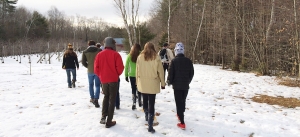


 On a crisp, chilly Monday morning, April 6th, 2015, the Lit and Land-ers—clad in fleeces and gloves and Bean Boots—boarded a bus to visit Mr. Hiza’s apple orchard in Nottingham, New Hampshire. Over the weekend, we read two of Mr. Hiza’s lovely meditations, so we were familiar with the unique history of the place. As we climbed onto the bus spring felt imminent on campus— snow patches were morphing into faux kettle lakes and robins were harmonizing, and the air smelled like warm, vanilla ponderosa pines. Naturally, while reading the meditations, I envisioned the orchard to be a similarly vernal scene. I giddily imagined apple blossoms and bird houses and fully vegetated birch trees. I even started Googling apple pie recipes, and searched for summer jobs on California orchards. But, as the bus rolled into the driveway at the orchard’s barn, it felt like January or February, still. The forest floor was covered in what seemed like fresh snow, and the apple trees were bare. Were PEA’s signs of early spring artificial? How could it be spring on campus, but still winter at the orchard? Do humans have sway over Spring?
On a crisp, chilly Monday morning, April 6th, 2015, the Lit and Land-ers—clad in fleeces and gloves and Bean Boots—boarded a bus to visit Mr. Hiza’s apple orchard in Nottingham, New Hampshire. Over the weekend, we read two of Mr. Hiza’s lovely meditations, so we were familiar with the unique history of the place. As we climbed onto the bus spring felt imminent on campus— snow patches were morphing into faux kettle lakes and robins were harmonizing, and the air smelled like warm, vanilla ponderosa pines. Naturally, while reading the meditations, I envisioned the orchard to be a similarly vernal scene. I giddily imagined apple blossoms and bird houses and fully vegetated birch trees. I even started Googling apple pie recipes, and searched for summer jobs on California orchards. But, as the bus rolled into the driveway at the orchard’s barn, it felt like January or February, still. The forest floor was covered in what seemed like fresh snow, and the apple trees were bare. Were PEA’s signs of early spring artificial? How could it be spring on campus, but still winter at the orchard? Do humans have sway over Spring?
We climbed out of the bus and the smell of cold pine trees rushed into our lungs—it was invigorating. While meandering toward the rows of apple trees, and I tried to imagine what the trees must look and smell like in the summer and autumn. How could such barren, skeletal forms yield the stuff of apple pie and apple butter (mmmm.. this makes my stomach growl!) in just a few moons’ time? It felt inconceivable. I suppose, being from coastal California where the only sign of seasons’ changing are evident in the aisles of Safeway (peaches come in the summer), I still carry some incredulity with me— drastic change in landscape, from ice to blossoms, feels far-fetched.
Before arriving in Exeter for the first time this autumn, I had always daydreamed of scenes of the quintessential New England blueberry farm or apple orchard. One of my passions is locally-sourced food, and I’ve been enamored with the concept of life on a farm or an orchard for some time now. I was so excited to visit a real-life apple orchard!
After walking past the rows of apple trees, we wandered into the adjacent forest and saw an old quarry used by the former residents of the colonial days. Near the quarry, there was a tiny pool which Mr. Hiza called a “vernal pond,” a little reservoir of fresh-snow melt. Alas, there were some signs of Spring! We explored the duff-covered grave-sites of the site’s colonial residents, the McCrillis family, and meandered through the woods back to Mr. Hiza’s house, where we were greeted by the alluring aroma of oatmeal chocolate chip cookies. It was so, so cozy and quaint! We explored the interior farm house, and Michael was intrigued by the home’s lack of parallel lines, which we are so accustomed to seeing in modern architecture. We climbed up the stairs into the attic, and saw the home’s loom, which residents of the past used. Mr. Hiza told us that the home has rooms specifically called “birthing rooms,” because earlier in the century, childbirth frequently took place in the home, not a hospital.
Warm and happy, the Lit and Land’ers munched on some scrumptious homemade peanut butter oatmeal chocolate chip cookies in the kitchen. I enjoyed imagining all of the home’s previous residents, the butter that was churned, the loaves of bread baked, the apple pies made. It felt like we were standing in a room full of stories and histories, full of memories, full of warmth and smiles in the midst of cold March winters. It was lovely.
-Ailis D


